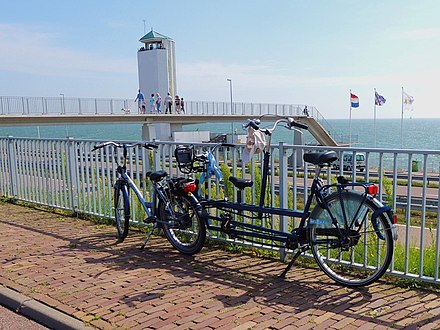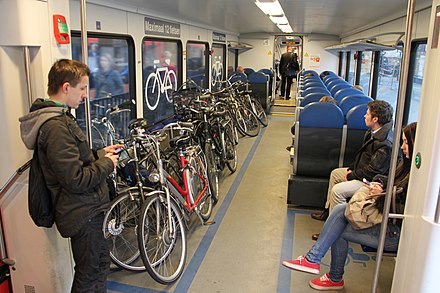Cycling in the Netherlands
Cycling in the Netherlands

Choosing a bike
Since the Netherlands are pretty much flat when it comes to terrain, you can do with any ordinary city bike. Having a few gears to choose from when having to cycle with your face first into the wind is recommended but not mandatory. Typically, your choice should go between a stadsfiets (city bike), often defined by model; a herenfiets (gentlemen's bike) will have the additional bar between the bike seat and the handlebar, whereas a damesfiets (lady's bike) does not. To get on a herenfiets, you would have to swing your leg over the backside of the bike, which wouldn't be the case with a damesfiets. If the bike does not have multiple gears, then the Dutch language counts it as outdated, which makes a herenfiets an opafiets (grandpa's bike) and a damesfiets an omafiets (grandma's bike). The latter usually set you back around €8 per day per bike, while stadsfietsen can cost around €2 more per day per bike.
E-bikes are often also available. These are more expensive, but are motorized to help you get up to speed. They can be rented for €15 to €20, but prices may vary depending on the rental service you're using as well as the region you're in.
Tandems are often an option in more tourist-y retreats, such as the West Frisian Islands, but can often be found at most major rental services. They can be obtained for just €16, or the price of two regular bikes. Tandems can fit two people at the same time.
Child seats (kinderzitjes), transport crates and bags (fietskratten and fietstassen) can often be obtained for an additional €2. Bikelocks are most often not necessary outside of the large cities. Most every bike is equipped with a simple lock underneath the bike seat, but chain locks may be provided by default in the larger cities.
Travelling with a bike

Bicycles are almost never allowed on a bus or tram.
Bicycles are allowed on domestic train journeys, but not during peak hours. Bike supplements with the name "Fietskaart Dal" sell for €7.20, which is a cost that gets added onto your regular ticket. Cargo bikes, children's bicycle trailers and handcarts are not permitted on the train.
Bicycles on international classic trains (IC Belgium towards Antwerp and Brussels) and IC Berlin) are allowed under certain conditions.(higher price for the bicycle ticket, extra bicycle reservation in the summer).
Bicycles of normal size on the Eurostar, Thalys and ICE international high-speed trains are not allowed.
Small folded bicycles under certain dimensions are allowed as normal luggage on all trains.
Destinations
Cities
Amsterdam is world renowned as a cycling city because it is the largest city, but there are smaller cities that even have higher cycling rates or impressive cycling infrastructure.
Some interesting cities that have won Fietsstad (Bicycle City) awards:
- Groningen
- 's-Hertogenbosch (Den Bosch)
- Zwolle
- Nijmegen In fact, every city or place in the Netherlands is good to bike, as long as you inform yourself what you want to visit and which route to take, according to your capabilities.
Other places
The Netherlands has a lot of natural areas with cycle paths through it.
The Achterhoek is a good area to bike.
The island of Texel is also a well-known biking destination, with varied and interesting landscapes to cycle in.
The Veluwe is a natural reserve known for having an infrastructure centered towards cycling. Usage of the white bicycles that are available is included in the entry fee. On some busy summer days, those typical white bicycles might already be taken, and you would have to rent a bike elsewhere.
Maps
A very detailed and free online cycling map is the bicycle layer of openstreetmap.org.
The same map can be viewed on cycling.waymarkedtrails.org where you can see easily the cycling routes on the map.
This OpenStreetMap, including the bcicycle view, can be viewed on smartphones using the free map app OsmAnd, and used also for basic navigation. Experienced bicycle tourists can find more advanced tools for navigation with the OpenStreetMap cycling map.
Routes
The Netherlands is littered with routes made specifically for cyclists.
Fietsknooppunten
.jpg/440px-Groningen_provincial_bicycle_routes_cross_point_(2017).jpg) Most domestic recreational cyclists will use fietsknooppunten (Cycling nodes) to stitch their own route together by linking several nodes. All of these nodes as well as the roads connecting them give a near-infinite variety of routes and are all surprisingly well documented through roadside signage.
Most domestic recreational cyclists will use fietsknooppunten (Cycling nodes) to stitch their own route together by linking several nodes. All of these nodes as well as the roads connecting them give a near-infinite variety of routes and are all surprisingly well documented through roadside signage.
Fietsknooppunten (Cycling nodes) are a lot of nodes on a map that you can cycle between. These points and the road to get there are well-signposted. You may sometimes see signs with “ U nadert knooppunt” which mean that you are approaching a node. Maps can be obtained from ANWB-stores, but are also found on a signpost at most cycling nodes. You can also download the Fietsknoop app available for Andriod, iOS and Windows Phone. To use the network, simply find a node close to your starting location, and plan out a route from there, following signage to get from node to node. A lot of routes are also pre-loaded on the app.
LF-routes
 More enthusiastic cyclists may want to use lange-afstandsfietsroutes (long distance bicycle routes) or landelijke fietsroutes (national bicycle routes), both abbreviated as and referring to the same LF-routes.
More enthusiastic cyclists may want to use lange-afstandsfietsroutes (long distance bicycle routes) or landelijke fietsroutes (national bicycle routes), both abbreviated as and referring to the same LF-routes.
LF-routes can be found in the Netherlands and Flanders:
- LF Kustroute (part of the international North Sea route EuroVelo 12) with a lot of dunes, natural areas, dams and bridges in the west
- LF Maasroute along the Meuse river
Stay safe
Unfortunately, bike theft is a common occurrence in the Netherlands, especially in bigger cities like Amsterdam. It would be best to invest in a bike lock when buying a bike. Rented bikes on the other hand often come with a perfectly capable lock included.
If bicycling in an area with canals, avoid falling into them. As silly as it sounds, thousands of bicycles fall into canals in Amsterdam every year, and the same caution should go for any other city that has canals.
In Amsterdam, Rotterdam, The Hague, Utrecht, and any other city that has them, be wary of tram rails, and always be sure to cross them at an angle. Large gaps between bike lane tiles should be treated the same way.
Although most of the cyclists in the Netherlands don’t usually wear knee-pads, helmets or any other safety measures, don't feel afraid to use them if you're not too sure about your own qualities when it comes to cycling. Cycling, including urban cycling, takes a bit to get used to, especially if you've only used a bike a few times in your life.